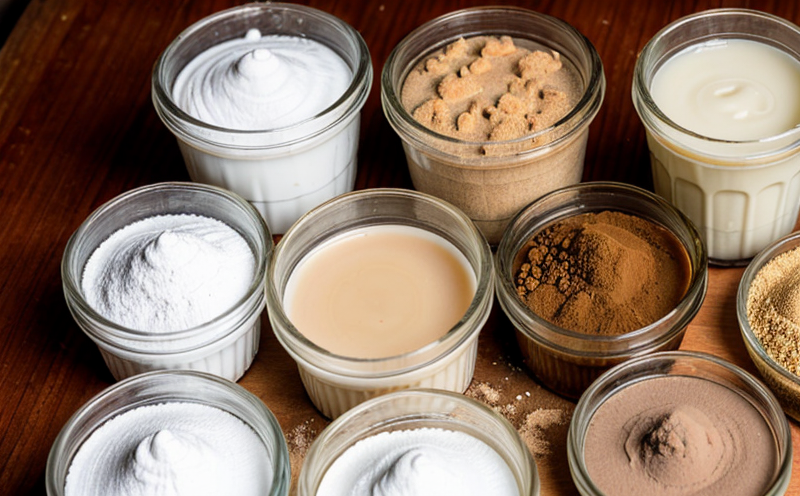EN 12322 Enumeration of Yeast Contamination in Animal Feed
The European Standard EN 12322 is a critical tool used by laboratories to enumerate yeast contamination levels in animal feed. This standard is essential for ensuring the quality and safety of feeds, as excessive yeast can negatively impact livestock health and productivity.
Yeast contamination in animal feed poses several risks. It can lead to nutrient imbalances, which may result in poor growth rates or reduced milk production. Additionally, certain types of yeasts produce toxins that are harmful to animals. The standard provides a robust method for quantifying these contaminants using a series of steps and specific criteria.
The procedure outlined in EN 12322 involves several key stages:
- Sample preparation: Ensuring the sample is representative of the feed being tested.
- Culture conditions: Specifying conditions under which yeast will be cultured to grow and become visible for counting.
- Counting method: The standard recommends a direct microscopic count, where yeasts are observed using a light microscope equipped with appropriate optics.
The methodology ensures that the results accurately reflect the levels of yeast contamination present in the feed. This is crucial for maintaining animal health and ensuring compliance with regulatory standards set by authorities such as the European Commission.
Accurate enumeration helps producers, retailers, and regulators to make informed decisions about feed quality and safety. By adhering to this standard, laboratories can provide reliable data that supports these critical judgments.
The importance of yeast contamination testing in animal feed cannot be overstated, especially for those involved in the production, processing, or regulation of such feeds. Understanding how EN 12322 fits into this broader context is essential for effective implementation and interpretation of results.
Scope and Methodology
The scope of EN 12322 includes the enumeration of yeast contamination in animal feed through microbiological methods. The method described here provides a standardized approach to identifying, quantifying, and reporting yeast levels. This ensures consistency across different laboratories, which is crucial for accurate and reliable results.
Under this standard, the procedure involves several critical steps:
- Sampling: Representative samples are taken from the feed batch being analyzed to ensure that the test reflects the overall yeast contamination present in the feed.
- Culture Conditions: The sample is subjected to specific culture conditions designed to promote the growth of yeast colonies, making them visible for counting. These conditions include temperature and incubation time parameters specified in the standard.
- Counting: The final step involves direct microscopic observation using a light microscope. The methodology ensures that only viable yeasts are counted by employing appropriate staining techniques to differentiate between living and dead cells.
The results of this enumeration provide valuable insights into yeast contamination levels, enabling stakeholders to take necessary corrective actions if required.
By following the precise procedures outlined in EN 12322, laboratories can ensure that their findings are accurate, reproducible, and compliant with international standards. This is particularly important for maintaining high-quality standards in animal feed production and ensuring consumer confidence in food safety practices.
Eurolab Advantages
At Eurolab, we bring decades of experience and expertise to bear on every project, leveraging our cutting-edge facilities and state-of-the-art equipment. Our team of highly skilled professionals ensures that all tests conducted are not only accurate but also fully compliant with international standards.
- Precision: Our advanced technology allows us to deliver precise results, ensuring accuracy in yeast enumeration.
- Consistency: We maintain stringent quality control measures throughout the testing process, guaranteeing consistent and reliable outcomes.
- Rigor: Eurolab adheres strictly to all relevant international standards, such as EN 12322, ensuring that our results are both valid and comparable across different laboratories.
- Expertise: Our team comprises experts in food safety and quality assurance who bring deep knowledge and experience to every project.
Our commitment to excellence is reflected in the high level of service we provide. Whether you need routine testing or specialized services, Eurolab stands ready to meet your needs with the highest standards of professionalism and integrity.
Use Cases and Application Examples
| Scenario | Description |
|---|---|
| R&D Projects | Innovative feed formulations often require rigorous testing to ensure they do not contain harmful levels of yeast. EN 12322 helps researchers identify potential issues early in the development process. |
| Quality Assurance | Regular testing ensures that feeds meet strict quality standards, protecting both animal health and producer reputation. |
| Regulatory Compliance | Ensures compliance with European regulations regarding feed safety and quality.|
| Purchase Verification | Determines the suitability of purchased raw materials or finished products for use in feed formulations. |
| Market Entry | Facilitates entry into new markets by ensuring that feeds meet local standards and regulations. |
- R&D Projects: The standard is essential for identifying potential issues early, ensuring the safety of innovative feed formulations.
- Quality Assurance: Regular testing helps maintain strict quality standards, protecting both animal health and producer reputation.
- Regulatory Compliance: Ensures that feeds meet European regulations regarding safety and quality.
- Purchase Verification: Determines the suitability of purchased raw materials or finished products for use in feed formulations.
- Market Entry: Facilitates entry into new markets by ensuring compliance with local standards and regulations.
The versatility of EN 12322 makes it a valuable tool across various sectors within food safety and quality assurance. Its comprehensive approach ensures that yeast contamination is effectively managed, contributing to the overall health and well-being of livestock.





